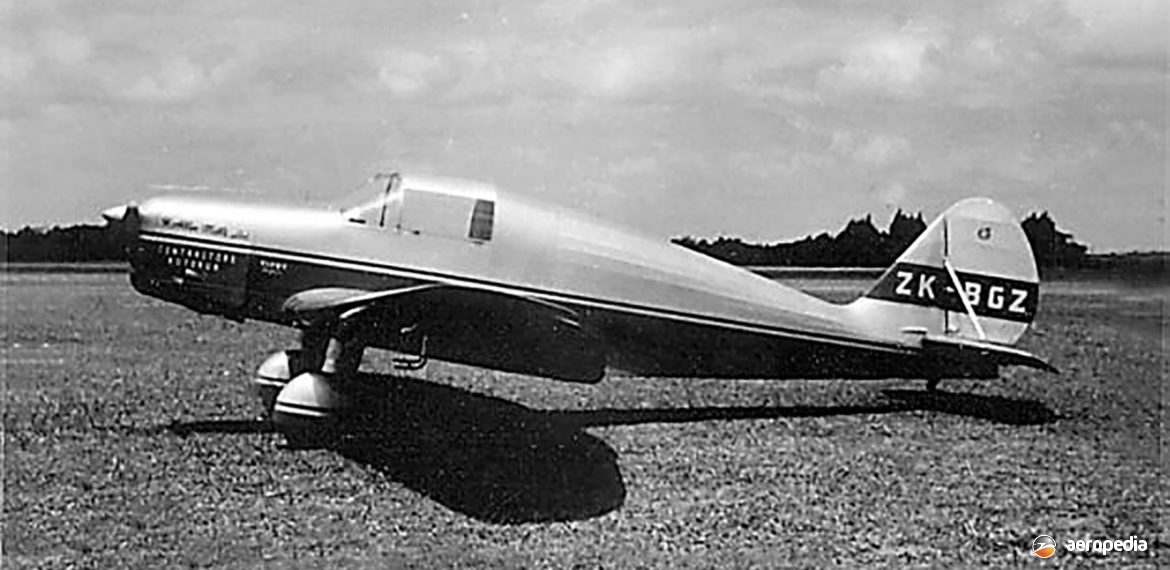Photograph:
Tipsy Belfair ZK-BGZ (c/n 532) in New Zealand (Ray Deerness) )
Country of origin:
Belgium
Description:
Two-seat sport and training monoplane
Power Plant:
One 46 kw (62 hp) Walter Mikron II four-cylinder in-line air-cooled engine
Specifications:
- Wingspan: 9.50 m (31 ft 2 in)
- Length: 6.64 m (21 ft 8 in)
- Height: 1.76 m (5 ft 8 in)
- Wing area: 11.98 m² (129 sq ft)
- Max speed: 177 km/h (110 mph)
- Cruising speed: 161 km/h (100 mph)
- Stalling speed clean: 70 km/h (44 mph)
- Initial rate of climb: 152 m/min (500 ft/min)
- Range: 748 km (465 miles)
- Fuel capacity: 59 litres (14 imp gals)
- Take-off run: 150 m (492 ft)
- Landing run: 200 m (656 ft)
- Empty weight: 283 kg (624 lb)
- Loaded weight: 487 kg (1,074 lb)
History:
Ernest Oscar Tips was the chief designer of Avions Fairey SA in Belgium in the 1930s, designing and building his first aircraft, the Tipsy S.1, a single-seat ultralight, in the Company’s works at Gosselies, Belgium in 1935. This aircraft (OO-TIP) was powered by a 21 kw (28 hp) Douglas Sprite engine and spent most of its life in England before being scrapped at West Malling in 1938.
In 1936 Aero Engines Ltd of Kingswood, Bristol came to an agreement with Ernest Tips to build the type under licence and the eighth Belgian built Tipsy S.2 (OO-ASA) was delivered to the United Kingdom to be used as a specimen for production, becoming G-AEOB. A batch of nine was laid down but problems with the type of glue used caused most to be grounded, and the last three were not completed.
Development led to the Tipsy B, known as the Trainer D, with a 46 kw (62 hp) Walter Mikron II engine driving a two-blade 23.6 cm (60 in) wooden Horden Richmond propeller, or a 25.98 cm (66 in) Fairey Reed metal propeller. This engine was licence-built in the United Kingdom by Tipsy Aircraft Ltd, this company being formed in June 1937. Some refinement to the design took place in order for it to meet United Kingdom airworthiness requirements. Changes to the design included an enlarged, mass-balanced rudder, a one piece elevator and, after six aircraft had been completed, slots in the leading-edges ahead of the ailerons.
In 1939 the second Tipsy B was modified as the Tipsy BC (biplace cabine) and this became the prototype for the Belfair two-seat cabin monoplane. Seven examples were built by Avions Fairey SA at Gosselies, the last three completed going to the United Kingdom. Structure was essentially similar to that of the pre-war Tipsy B, being built entirely of wood, apart from duralumin tube formers of the fuselage decking. A couple of long-distance flights were achieved for aircraft in its class, ie, 945 kg (2,083 lb) including, in 1950, 945 km (587 miles) and, in 1955 2,632 km (1,635 miles).
One example, the second built, was registered in New Zealand. This aircraft ZK-BGZ (c/n 532 – ex OO-TIB) was first registered on 3 November 1954 to H Allan Mills Ltd of Rotorua. On 15 October 1956 ownership was transferred to Mr E Wilkie of Invercargill, but on 8 December that year it crashed into pine trees near Rotorua and was destroyed, the registration being cancelled on 31 October 1957. One example survives in airworthy condition in the United Kingdom as G-APIE.

